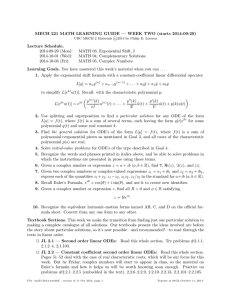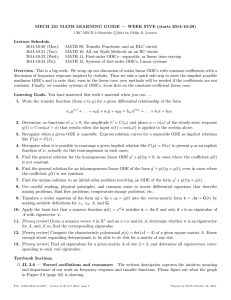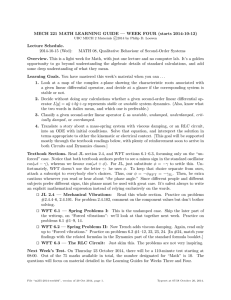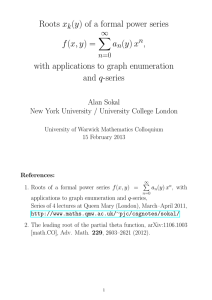Document 11126919
advertisement
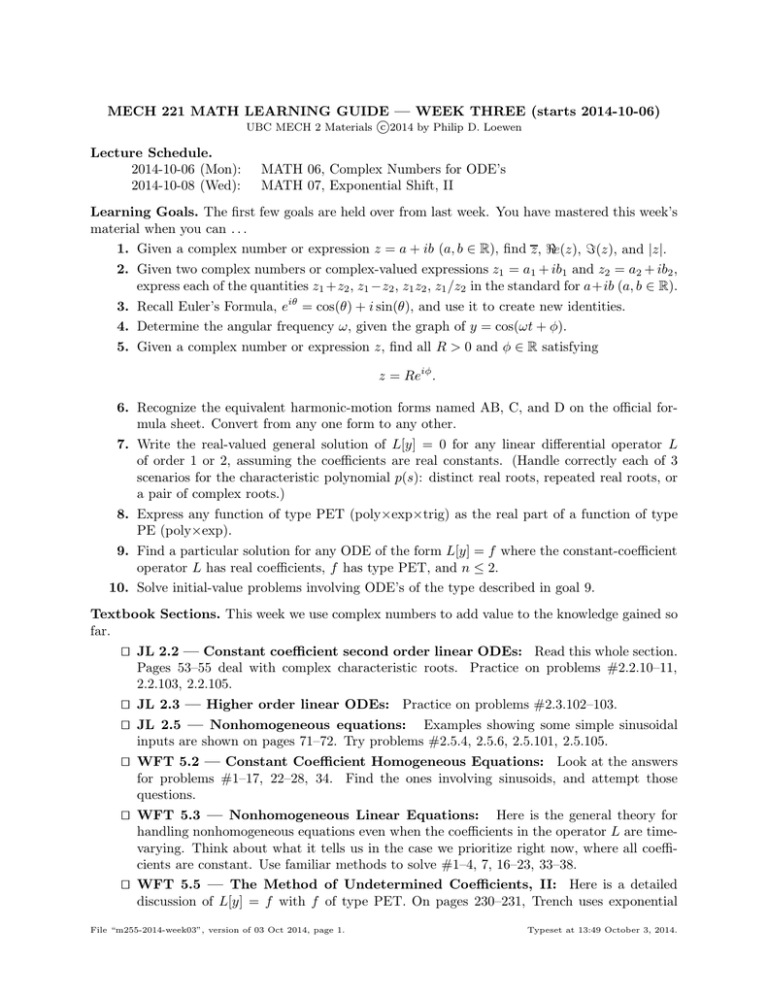
MECH 221 MATH LEARNING GUIDE — WEEK THREE (starts 2014-10-06) c 2014 by Philip D. Loewen UBC MECH 2 Materials Lecture Schedule. 2014-10-06 (Mon): 2014-10-08 (Wed): MATH 06, Complex Numbers for ODE’s MATH 07, Exponential Shift, II Learning Goals. The first few goals are held over from last week. You have mastered this week’s material when you can . . . 1. Given a complex number or expression z = a + ib (a, b ∈ R), find z, ℜe(z), ℑ(z), and |z|. 2. Given two complex numbers or complex-valued expressions z1 = a1 + ib1 and z2 = a2 + ib2 , express each of the quantities z1 +z2 , z1 −z2 , z1 z2 , z1 /z2 in the standard for a+ib (a, b ∈ R). 3. Recall Euler’s Formula, eiθ = cos(θ) + i sin(θ), and use it to create new identities. 4. Determine the angular frequency ω, given the graph of y = cos(ωt + φ). 5. Given a complex number or expression z, find all R > 0 and φ ∈ R satisfying z = Reiφ . 6. Recognize the equivalent harmonic-motion forms named AB, C, and D on the official formula sheet. Convert from any one form to any other. 7. Write the real-valued general solution of L[y] = 0 for any linear differential operator L of order 1 or 2, assuming the coefficients are real constants. (Handle correctly each of 3 scenarios for the characteristic polynomial p(s): distinct real roots, repeated real roots, or a pair of complex roots.) 8. Express any function of type PET (poly×exp×trig) as the real part of a function of type PE (poly×exp). 9. Find a particular solution for any ODE of the form L[y] = f where the constant-coefficient operator L has real coefficients, f has type PET, and n ≤ 2. 10. Solve initial-value problems involving ODE’s of the type described in goal 9. Textbook Sections. This week we use complex numbers to add value to the knowledge gained so far. ⊔ JL 2.2 — Constant coefficient second order linear ODEs: Read this whole section. ⊓ Pages 53–55 deal with complex characteristic roots. Practice on problems #2.2.10–11, 2.2.103, 2.2.105. ⊔ JL 2.3 — Higher order linear ODEs: Practice on problems #2.3.102–103. ⊓ ⊔ JL 2.5 — Nonhomogeneous equations: Examples showing some simple sinusoidal ⊓ inputs are shown on pages 71–72. Try problems #2.5.4, 2.5.6, 2.5.101, 2.5.105. ⊔ WFT 5.2 — Constant Coefficient Homogeneous Equations: Look at the answers ⊓ for problems #1–17, 22–28, 34. Find the ones involving sinusoids, and attempt those questions. ⊔ WFT 5.3 — Nonhomogeneous Linear Equations: Here is the general theory for ⊓ handling nonhomogeneous equations even when the coefficients in the operator L are timevarying. Think about what it tells us in the case we prioritize right now, where all coefficients are constant. Use familiar methods to solve #1–4, 7, 16–23, 33–38. ⊔ WFT 5.5 — The Method of Undetermined Coefficients, II: Here is a detailed ⊓ discussion of L[y] = f with f of type PET. On pages 230–231, Trench uses exponential File “m255-2014-week03”, version of 03 Oct 2014, page 1. Typeset at 13:49 October 3, 2014. 2 PHILIP D. LOEWEN shift to strip off only the real exponential part of f , leaving the sinusoid to be handled by real methods. This is an interesting and valid alternative to the fully complexified approach advocated in class. Practice, by either method, on #1–17, 22–26, 27–32, 40. Next Week’s Test. On Thursday 16 October 2014, there will be a 110-minute test starting at 08:00. Out of the 75 marks available in total, the number designated for “Math” is 0. File “m255-2014-week03”, version of 03 Oct 2014, page 2. Typeset at 13:49 October 3, 2014.
